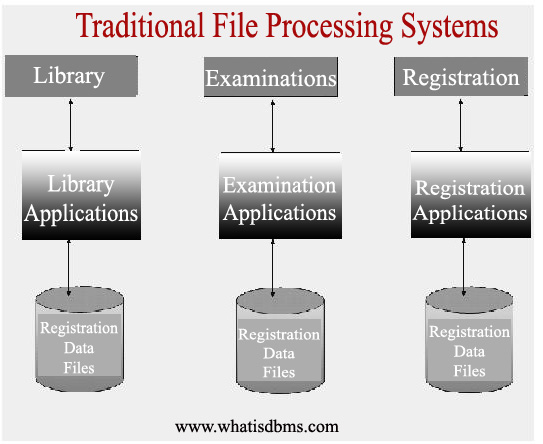What is Traditional File Processing System And Its Characteristics: Before the use of computer, a manual file system was used to maintain the records and files. All the data was stored in files and it makes it easy to find any information. But this system was good only for small organizations having small number of items.
Also See: Characteristics of Database Approach
It has many disadvantages given below:
- It was time consuming.
- Inefficient to maintain the record of big firm having large number of items.
- It requires a lots of labor work to do.
- It becomes more complex when anyone requires changing the information.
Also See: 25 Examples of Popular Database Management Systems
To overcome these disadvantages and to make the processing fast, File Processing System was introduced. This system was able to solve all the above problems. Let us find what Traditional File Processing System was.
What is Traditional File Processing System And Its Characteristics
Traditional File Processing Systems
It was totally computer based system where all the information is store in different computer files. Also traditional files system stores data in a manner that all the departments of an organization have their own set of files that creates data redundancy.
Also See:Complete Guide: Denormalization in Database (DBMS)
For example:
To illustrate Traditional File Processing Systems definition, lets us take an example of college where student record for examination is stored n other file and his library record is stored in different file that creates many duplicate values like roll Number, Name and Father Name.
A typical Traditional File Processing Systems is shown in the diagram that shows program and data independency.

The main highlighted in this figure is data and program independency. It means that data and program depends upon each other. And due to this, any change in one file will affect all the others files too.
Also See: Advantages of Database Management System
There are many characteristics of Traditional File Processing Systems that are given below.
Characteristics OF Traditional File Processing System
- It stores data of an organization in group of files.
- Files carrying data are independent on each other.
- COBOL, C, C++ programming languages were used to design the files.
- Each file contains data for some specific area or department like library, student fees, and student examinations.
- It is less flexible and has many limitations.
- It is very difficult to maintain file processing system.
- Any change in one file affects all the files that creates burden on the programmer.
- File in Traditional File Processing Systems are called flat files.
Also See: What is Serializability in DBMS? Types, Advantages, and Significance
Overall, Traditional File Processing Systems was good in many cases in compare to manual non computer based system but still it had many disadvantages that were overcome by Data Base Management System.
Also See: File Organization in DBMS
We hope you get the basic idea behind Traditional File Processing Systems and its characteristics. If you have any doubt about this topic then please comment below, we will surely solve it. If you liked it then please share it with your friends.
how change in one file affects whole file
like if you change the address in one file than it will just reflect in the file in which you have changed in other file there exists the same address that you have given before so its better to use dbms than to use traditional file processing system
i don’t get point of program and data independency
Even I don’t get the same point of data independence…
so if a change in one file affects other files then what do you mean when saying files are independent
Is Rdbms and Dbms is same thing or they are different from each other please clear this basic concept.. Thank you
RDBMS has got to do with relational databases then DBMS Is for both relational and non relational databases. So theres\’s just a slight difference
For those who don’t get about Data independence… basically what is being said is that in a traditional file processing system records are stored indenpendly file and one does not depend on another so if you make some changes on one of the files you will have to manualy update the rest of the files
where is types of traditional file base system and advantages & dis-advantages of TFBS
Can you think an organization where traditional file processing approach for storing data will be more beneficial as compared to database approach?